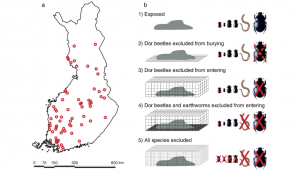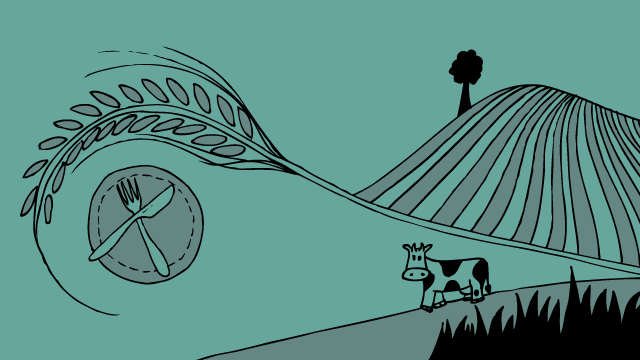A recent statistic from the FAO estimates that there are more than 1.4-billion cows currently living on Earth. Spread across the world in many different ecosystems, these large animals play a significant role within our food production systems. Unfortunately, they also leave us with an inordinately large, often problematic dung problem to manage.
Though it might not be immediately obvious, decomposition of dung is a critical ecosystem service. Benefits associated with dung decomposition include: an increased rate of grass regrowth, a reduction in the volatilisation of ammonia, a decrease in the emergence of dung-inhabiting pests (biting flies, GI-parasites), and optimising herd foraging (most animals will not graze in proximity to other manure pats). This service is provided by a diverse community of organisms including flies, beetles, worms, and bacteria.

The dung of a cow. Known colloquially as: dung pat, cow pat, cow pie, cow chip, etc. Photo: USDA Public Domains
One group of organisms long understood to play a significant role within this ecosystem service are dung beetles. They speed up the process of dung decomposition through acts of coprophagy , and through tunneling, burying, and rolling. A recent microcosym study by Rosenlew and Roslin (2008) found that a large dor beetle (genus Geotrupes) provided a much greater service of dung removal than abundant and diverse assemblages of smaller dung beetles.
An important consideration is that most studies on dung decomposition have been conducted at small spatial scales. The recent study by Rofsenlew and Roslin (2008) was completed on an area of land less than 1-ha which is not uncommon for microcosm studies. This prompted several researchers to ask: Is it possible to measure an ecosystem service nationwide? The answer is ‘Yes’, although it required the efforts of a new generation of scientists.
A study published by Kaartinen et al (2013) in Ecology rounded-up 82 citizen scientists from the 4H Federation of Finland. Each participant was given detailed instructions to carry out a replicated experimental design. Armed with 20L of cattle dung, each citzen scientist placed fifteen 1.2L dung pats within, or directly adjacent to pastures where cattle had been grazing for at least three days. Ten pats were assigned to experimentally determine rate of decomposition provided by different dung-feeding guilds (Figure 1). The other five were used to sample dung beetle occurrence within each site.

Figure 1: Distribution of sampling sites of Finland (L). Overview of exclusion treatments to determine significance of different functional groups. (Kaartinen et al. 2013)
Citizen scientists measured the mass of each dung pat every 10 days for the first two months of the study. These measurements were submitted through an online service. To account for mass gains due to precipitation, participating citizen scientists also reported meteorological data throughout the duration of the study. The amount of data that the research team was able to collect was outstanding! Due to some dung pats being accidentally destroyed, the team was able to collect 4,180 measurements of 733 individual dung pats over 73 farms.
The leading scientists of this study, then modeled decomposition rate as a function of experimental treatment, time, latitude and occurrence of rain, along with a biologically motivated two-way interaction between: treatment x time, time x rain, treatment x rain.
The research team found that the pats excluded from all invertebrate decomposers were the heaviest, while the exposed treatment had the lightest pats. Each additional group of decomposers excluded resulted in a significant increase in the amount of dung remaining. Kaartinen et al. (2013) demonstrated the results of their model in a truly beautiful, and clear way. It can seen below in Figure 2.

Figure 2: The scale and players of an ecosystem service. Within the middle fraction, the dark brown cube represents sites in northernmost Finland, while the light brown box represents the southernmost Finland. Kaartinen et al. (2013)
Interestingly, the study found that the warmer climate in southernmost Finland had a larger effect on dung decomposition than the overall presence of invertebrates. This effect was found due to the wide geographic range associated with this citizen science incentive. The study also found that dor beetles remove dung twice as quickly as smaller dung-dwelling beetles and earthworms, supporting the findings by Rosenlew and Roslin (2008).
While many studies use citizen science to observe and record data, this study took it a step further through using experimental manipulations. The network of citizen scientists allowed the researchers to save considerable costs, while uncovering valuable trends in understanding the drivers of dung decomposition. It also provided an opportunity for 82 young scientists to gain experience in ecology, and to practice using the scientific method. This study will surely act as a successful model to highlight the opportunity in harnessing the power of citizen science.
References:
Rosenlew, H. and Roslin, T. (2008), Habitat fragmentation and the functional efficiency of temperate dung beetles. Oikos 117: 1659–1666.
![Scaling-up Scat Studies: A Story of Citizen Science A recent statistic from the FAO estimates that there are more than 1.4-billion cows currently living on Earth. Spread across the world in many different […]](/wp-content/uploads/2013/11/ethical-eating-620x300.png)
